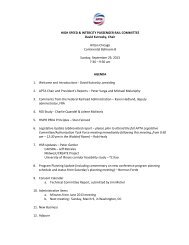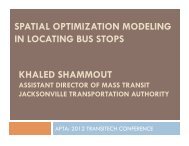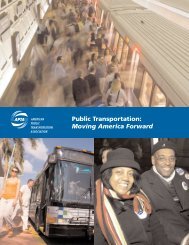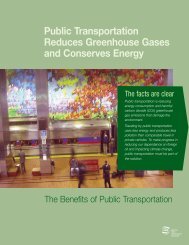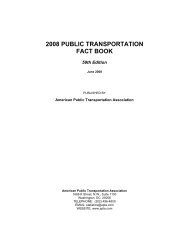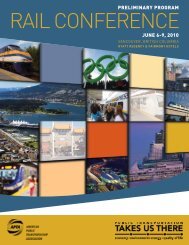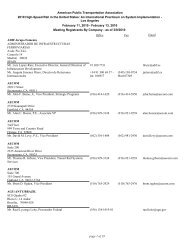2012 APTA Fact Book Appendix A - American Public Transportation ...
2012 APTA Fact Book Appendix A - American Public Transportation ...
2012 APTA Fact Book Appendix A - American Public Transportation ...
Create successful ePaper yourself
Turn your PDF publications into a flip-book with our unique Google optimized e-Paper software.
<strong>2012</strong> <strong>Public</strong> <strong>Transportation</strong> <strong>Fact</strong> <strong>Book</strong>,<br />
<strong>Appendix</strong> A: Historical Tables<br />
Page 136<br />
Household is a U.S. Census term for the group of all people who occupy a particular housing unit as their<br />
usual residence, or who live there at the time of the Census interview and have no usual residence<br />
elsewhere. The usual residence is the place where the person lives and sleeps most of the time.<br />
Means of <strong>Transportation</strong> to Work is the usual travel mode in the previous week for a commuter<br />
answering the Census survey. Only a single mode can be reported even if the respondent uses multiple<br />
modes. The respondent is directed to select the mode used for the longest distance. No selection<br />
instruction is provided for respondents who use different modes on different days.<br />
Railroad is a U.S. Census transit mode name that is the same as "Commuter Rail" as used by <strong>APTA</strong> and<br />
the FTA.<br />
Streetcar or Trolley Car is a U.S. Census Transit mode name that is the same mode as "Light Rail" as<br />
used by <strong>APTA</strong> and the FTA.<br />
Subway or Elevated is a U.S. Census transit mode name that is the same mode as "Heavy Rail" as used<br />
by <strong>APTA</strong> and the FTA.<br />
VEHICLE CHARACTERISTICS DEFINITIONS:<br />
Accessible Vehicles are transit passenger vehicles that are accessible to, are usable by, and provide<br />
allocated space and/or priority seating for individuals who use wheelchairs.<br />
Alternate Fuel Powered Vehicles are vehicles powered by fuel that is substantially not petroleum.<br />
Average Vehicle Age is the number of years old all revenue vehicles are divided by the number of<br />
vehicles. The years of age are counted as one-half year for the year in which a vehicle was built plus one<br />
year for each calendar year since then.<br />
Federal Transit Administration Minimum Useful Life is the age a revenue vehicle must be before an<br />
agency can receive federal financial assistance to replace that vehicle. The useful life varies by type of<br />
vehicle and may be shorter than stated for vehicles with excess use measured by miles travelled.<br />
Revenue Vehicle (also called a passenger vehicle) is a vehicle in the transit fleet that is available to<br />
operate in revenue service carrying passengers, including spares and vehicles temporarily out of service<br />
for routine maintenance and minor repairs. Revenue vehicles do not include service vehicles such as tow<br />
trucks, repair vehicles, or automobiles used to transport employees.<br />
Revenue Vehicles Available for Maximum Service are vehicles that a transit agency has available to<br />
operate revenue service regardless of the legal relationship thorough which they are owned, leased, or<br />
otherwise controlled by the transit agency. Also called vehicles owned and leased.<br />
Revenue Vehicles Used in Maximum Service is the largest number of vehicles an agency uses to<br />
provide service at any time during a typical day. Also called peak period vehicles.<br />
VEHICLE EQUIPMENT DEFINITIONS:<br />
Automated Stop Announcement is an automated system that announces upcoming stops.<br />
Automatic Passenger Counter equipment counts passenger boardings/alightings but is not part of the<br />
farebox.<br />
Automatic Vehicle Location or GPS equipment allows a vehicle to be electronically located or tracked<br />
by local sensors or satellites.



